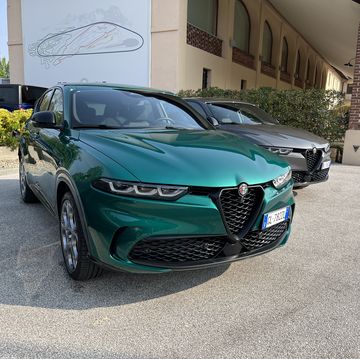The correct way to drive a Lotus Cortina is on three wheels. Get the car turned in, wait a beat as it takes a set, shifting seemingly all its weight to the outside rear tire, hold the steering steady, adjust your line with the throttle, and get ready to do it all again. That's what Jim Clark did, and who are you to argue with Jim Clark?
Ford's Cortina was the most typical of typical English family sedans during the Sixties and Seventies. A right-hand drive, slightly smaller, Falcon. The Blue Oval was on a motorsport kick at the time of the Cortina's 1962 launch, so it tapped Lotus to create a high-performance version for the saloon-car racing that was so popular in the UK at the time. Lotus had established a relationship with Ford supply engines for the then-new 1962 Elan roadster. The Lotus Twin-Cam was a slightly enlarged (1557cc, badged as a 1.6-liter) version of the venerable Ford Kent four-cylinder, with a Lotus designed twin-cam head. Ford UK's PR man, Walter Hayes, figured sticking this engine into a Cortina, would produce an ideal saloon-car racer. Hayes had Colin Chapman and his Lotus company rework the Cortina and build 1000 examples for homologation.
The result was such a sleeper. At first glance, the Lotus Cortina doesn't look like much except for its green stripe, but then there’s how it hunkers over on its 13-inch steel wheels. Lotus reworked the suspension with shorter struts and a huge sway bar up front, and coils replacing the leaf springs out back. The doors, hood, trunk, and differential housing were all replaced by aluminum replicas, and the Elan's close-ratio gearbox was drafted in to partner the twin-cam.
Drive one and it’s quickly apparent that selling these to the general public at Ford dealership was a hilarious idea. This one belongs to R&T contributor Jamie Kitman, a longtime collector of European esoterica. It's an early example from 1963 with all the lightweight goodies and special Lotus parts. These were just a bit too light and fragile—in the great Lotus tradition—and were gradually phased out over the three-year production run of the Mk1 Lotus Cortina. (Mk2 Lotus Cortinas were a lot more Ford than Lotus, and built in-house.)
So while it's arguably more delicate, Kitman's example is the purest of Lotus Cortinas. It's astonishingly raw. "Race car for the road" is a cliche, but this Lotus Cortina truly is a race car for the road. The engine blares constantly, the suspension is unforgiving, and the steering is unbelievably sharp. The car darts into corners in a way you just don't expect from something of this vintage. It's a little scalpel, with very little body roll and steering that tells you everything you need to know through a gorgeous thin-rimmed wood wheel.
The engine is surprisingly slow revving, but 1.6 liters was fairly large for a European four-cylinder of the time. It's strong, though, doing its best work up to around 4500 rpm. Claimed output is 105 hp, and with only around 1900 pounds of car to move around, it propels the Cortina along nicely. Still, this is a momentum car, where pace along a section of road, or around a lap of the track comes from maintaining speed through the corners and braking as little as necessary. Using the short ratios from the Elan means the Lotus Cortina isn't exactly a relaxed cruiser at highway speeds—a noisy differential doesn't help either—but it does have a sweet shift. The transmission is fully synchronized and there's a wonderful metal-on-metal feel with every change.
For as much as this engine and gearbox transformed the Cortina, what sticks out now is the way it gets into a corner. Kitman let me drive this car a handful of times, and I'm always surprised at how sharp it is on turn in; how alive it feels when hustled down a curvy road. It's a riot. It's almost rude for something that looks like a cute little old car.
Imagine that Carroll Shelby and Shelby American made a GT350R out of a Ford Falcon, a humdrum sedan turned into a dominating race car, and sold to the public in barely tamed form. That's basically the idea. And yes, the original Mustang wasn’t much more than a pretty Falcon anyhow.
The Lotus Cortina is comically over-the-top in its aggression, but that makes sense because it wasn't intended to be daily transportation—it's a race car, through and through. No wonder why Ford gradually refined the Lotus Cortina into a usable, but still fast, family sedan.
It's evocative of the E30 M3. For all of its adoration today, the original M3 was compromised. It's not a perfect analogue for the Cortina, as an E30 M3 is reasonably livable, aside from its hornet's nest four-cylinder, yet it was as close to race-car-for-the-road as cars got in its day. The sort of thing you really don't see anymore either. A Civic Type R or a GR Corolla gives touring-car vibes, yet both are easy daily drivers. You wouldn't want to drive an E30 M3 every day, and certainly not a Lotus Cortina either.
Like the E30 M3, the Lotus Cortina dominated at the track. In saloon car racing, it was the perfect middle point in between the light, nimble Mini and the powerful, heavy Jaguar Mk2. Brawny, yet precise and delicate all the same. In 1964, Jim Clark won his class in all eight rounds of the British Saloon Car Championship with a Lotus Cortina, Sir John Whitmore won the title for his class in the 1965 European Touring Car Championship, and the list goes on.
Surely I didn't push Kitman’s Cortina nearly hard enough to get up on three wheels a la Clark, but it's still an exhilarating drive. The Lotus Cortina takes you to a different world. Everywhere suddenly feels a bit more like Goodwood than it did before and even if you're not a history-nerd like myself, nostalgic for an era before my time, it's impossible not to love the Lotus Cortina's singularity of purpose. Few cars are quite so special.
A car enthusiast since childhood, Chris Perkins is Road & Track's engineering nerd and Porsche apologist. He joined the staff in 2016 and no one has figured out a way to fire him since. He street-parks a Porsche Boxster in Brooklyn, New York, much to the horror of everyone who sees the car, not least the author himself. He also insists he's not a convertible person, despite owning three.

















